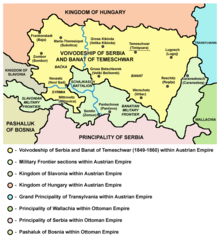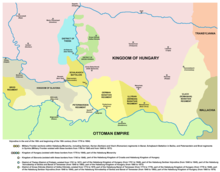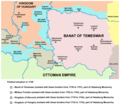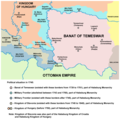Banat Military Frontier
| Banat Military Frontier | |||||||
|---|---|---|---|---|---|---|---|
| Districtof theMilitary Frontier,Habsburg monarchy | |||||||
| 1751–1873 | |||||||
 1849–60 political map | |||||||
| History | |||||||
• Established | 1751 | ||||||
• Disestablished | 1873 | ||||||
| |||||||
| Today part of | Hungary Serbia Romania | ||||||
TheBanat Military Frontieror simplyBanat Frontier(Serbian:Банатска крајина/Banatska krajina;Romanian:Granița militară Bănățeană;German:Banater Militärgrenze) was a district of theHabsburg monarchy'sMilitary Frontierduring the 18th and 19th centuries. It was located in southern parts of theBanatregion. It was formed in 1764, out of territories of theBanat of Temeswar.Today, the territory is split betweenSerbiaandRomania.[1][2]
Geography
[edit]The Frontier was divided intoSerb(Illyrian),German(Danube Swabian) andRomanian(Vlach) sections. It included parts of modern-dayBanatand the south-eastern part ofBačkaregion, known asŠajkaška.Some of the important cities and places were:Pančevo,Bela Crkva,Titel,Žabalj,Alibunar,Kovin,andCaransebeş.
History
[edit]The military province ofHabsburg monarchyknown as theBanat of Temeswarwas created in 1718. In 1751,Maria Theresaintroduced a civil administration for the northern part of the province. The southern part remained under military administration and was organized as the Banat Military Frontier. In 1849, this part of the Military Frontier bordered thePrincipality of Serbiato the south,Voivodeship of Serbia and Banat of Temeschwarto the north,TransylvaniaandWallachiato the east, and theSlavonian Military Frontierto the west. It remained a part of the HabsburgMilitary Frontieruntil it was abolished in 1871.
-
Map of Military Frontier sections in Syrmia, Bačka, and Pomorišje in 1718–44
-
Map of Military Frontier sections in Syrmia, Bačka, and Pomorišje in 1744–50
-
Map of Military Frontier sections in Syrmia, Bačka, and Banat in 1751–1778
Administration
[edit]
| Division | Seat | Notes |
|---|---|---|
| German | Pančevo | |
| Romanian (Vlach) | Caransebeș | |
| Serbian (Illyrian) | Bela Crkva |
Demographics
[edit]1857
[edit]Total of 386,255 people:[3]
- 314,514 (81.43%)Eastern Orthodox
- 51,860 (13.43%)Roman Catholics
- 19,418 (5.03%)Evangelists
- 393 (0.1%)Jews
- 70 (0.01%) others
See also
[edit]References
[edit]- ^Ilić-Mandić 2020,p. 99-121.
- ^Ilić-Mandić 2022a,p. 207-228.
- ^Bundesministerium für Inneres (1859).Statistische Übersichten Über Die Bevölkerung und Den Viehstand Von Österreich. Nach Der Zählung Vom 31. October 1857.p. 176.
Sources
[edit]- Dabić, Vojin S. (2011)."The Habsburg-Ottoman War of 1716-1718 and Demographic Changes in the War-Afflicted Territories".The Peace of Passarowitz, 1718.West Lafayette: Purdue University Press. pp. 191–208.
- Ilić-Mandić, Jelena (2020)."The Local Elite in Central Government Service: Banat Military Frontier Officers in the 18th Century".The Habsburg State-wide and the regions in the Southern Danube basin (16th-20th centuries).Wien: New academic press. pp. 99–121.
- Ilić-Mandić, Jelena (2021)."Forging the Wallachian Military Border, 1769-1772"(PDF).Banatica.31(2): 251–273.
- Ilić-Mandić, Jelena (2022a)."Making the Border and Frontiersmen: Militarisation in Temeswarer Banat, 1764-1775".From medieval frontiers to early modern borders in Central and South-Eastern Europe.Berlin: Peter Lang Publishing. pp. 207–228.
- Ilić-Mandić, Jelena (2022b)."The Military Frontier and Emigration Challenges in the 18th Century"(PDF).Migrations in the Slavic Cultural Space From the Middle Ages to the Present Day.Lódź: Wydawnictwo Universytetu Lódzkiego. pp. 45–62.
- Kılıç, Orhan (1997).18. Yüzyılın İlk Yarısında Osmanlı Devleti'nin İdari Taksimatı: Eyalet ve Sancak Tevcihatı.Elazığ: Şark Pazarlama.
External links
[edit]



